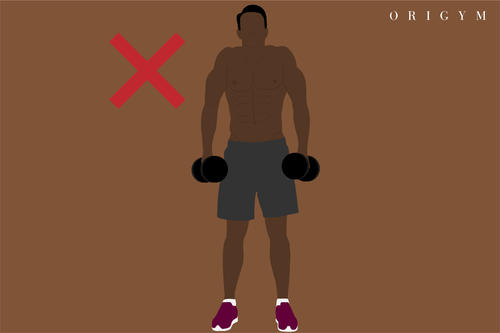How To Do The Lateral Raise | Videos + Guide
Wondering ‘what is a lateral raise?’ or maybe you already know what a lateral raise is, and you want to know how to get the most out of the movement? Whether you’re a beginner or a shoulder-building pro, you’re in the right place for everything you need to know about this exercise.
Before you carry on reading, why not check out our Personal Training Diploma or Level 2 qualification in fitness instructing first and see how you can turn your passion for fitness into a full-time career!
What Is A Lateral Raise?
The lateral raise is a shoulder-strengthening exercise which targets the lateral deltoid. Working on your lateral delts will build the size of your shoulders, creating the desired V-shaped torso and making your waist look smaller.
Lat raises (sometimes called side raises) also have benefits for increasing your shoulder mobility and strengthening your core muscles, too.
The movement itself is relatively simple, but don’t be fooled! Even with a light pair of dumbbells, by the end of your first set you’ll definitely feel the burn of this exercise working your shoulders.
Want broader shoulders? Find how to do a lateral raise below with our step-by-step guide and tutorial video.
Then, keep reading to learn how you can adapt the exercise to make it easier or more difficult depending on your ability.
How to Do A Lateral Raise

Set-Up and Equipment:
To execute the lat raise, all you’ll need is a pair of dumbbells and enough space to lift your arms upwards from your sides so that they’re parallel with your shoulders (you end up in a cross shape).
It doesn’t matter if you can smash a set of heavy weights doing a shoulder press, you need to start lightly with side raises. If you haven’t tried a lateral raise before, choose a pair of light-weight dumbbells for your first set up – we’ll explain why this is important shortly.
Starting Position:
- Stand upright with your feet hip-width apart.
- Stand with your arms down by your sides, holding a dumbbell in each hand with your palms facing in.
- Look straight ahead.
- Roll your shoulders back and pull your shoulder blades together, keep your back straight and engage your core to keep your posture.
- There should be a slight bend in your elbow.
Execution:
- Raise both of your arms outwards, slowly lifting the dumbbells up and out to the side.
- Keep the slight bend in your elbow during the movement.
- Raise the weights until your elbows are in line with your shoulders so that your arms are parallel to the floor.
- Pause at the top of the move for a second (this is the cross position).
- Lower the dumbbells back down slowly, stopping just before you reach the starting position.
- Repeat!
Lateral Raise Muscles Worked
Main Muscles Worked: lateral deltoids.
Secondary Muscles Worked: anterior deltoids, the supraspinatus, and the trapezius muscles.
Common Mistakes
Raises are a free-weight isolation exercise so it can be difficult to get the movement right at first. Here are a couple of common mistakes to look out for to make sure you get your form and execution right:
Using Too Much Weight

The majority of mistakes made when performing the lateral raise are related to using too much weight. We can’t stress enough that you shouldn’t get ahead of yourself with this move. It’s better to start light and ensure you can perform every rep with perfect form. You can always move up a weight for your next set if you think you can handle it.
With exercise in general, using a weight that is too heavy makes it more likely that you’ll have poor form when executing the move which will increase your risk of injury. The problem with lateral raises specifically is that the majority of people won’t go for the lighter weight as recommended.
If you do the move correctly, you’ll target the lateral deltoids specifically which will make the last few reps of your set a struggle even with lighter weights. Lat raises are an isolation exercise, so you’ll see the benefits of the move for your lateral deltoids without needing as much weight as you’d use for a compound exercise.
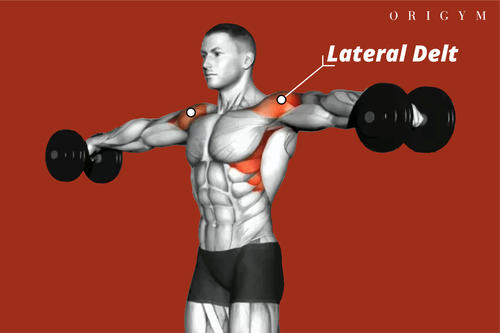
And because this raise is a unilateral move, you’ll need a weight light enough to accommodate to your less dominant side. When you do a bilateral weight-training move like a shoulder press, the stronger side of your body usually takes on more of the stress. With this unilateral move, both sides of your body have to be able to lift the same amount of weight.
Using a weight that’s too heavy will actually make the move less effective for targeting your lateral deltoids. If you try lat raises with a dumbbell that is too heavy for you, your deltoids won’t be able to power the movement and your traps will take over. You’ll know this is happening if you feel the exercise working in your neck.
Become a Personal Trainer with OriGym!
- Qualify & start earning in just 2 weeks
- Study full-time, part-time or online
- Endorsed by CIMSPA
Swinging the Weight
When it comes to executing this exercise, a lot of people make the mistake of swinging their arms to the cross position.
It’s important to keep your torso stationary throughout the move. If you find yourself rocking your torso back to give the dumbbells some momentum to move your arms up, you probably need to grab a lighter set of weights.
By swinging your arms or bouncing your knees to add momentum to the movement, you stop the exercise targeting the lateral deltoids and transfer the stress of the move onto your legs and your back. This will prevent the move from producing any real benefits for your lateral deltoids. Keeping your form and getting the execution right is key.
Top tip: if you’re struggling to raise the dumbbells without swinging your arms up, focus on leading the move with your elbows. If you start the move by raising your elbow and keep the slight bend in your elbow, you’ll target the lateral delts.

To stop yourself from swinging the weight, at the start of the move, try raising your arms a few inches and taking a brief pause before moving your arms to the cross position. This pause will help to make sure that you’re using your deltoids for the move.
Dropping Your Elbows
As well as focusing on your elbows to drive the movement of your arms, it’s important to make sure that the level of your elbow doesn’t drop below your wrist. Because your elbow is slightly bent, it should be the highest part of your arm when you’re in the cross position.
If your elbow is lower than your wrist, the anterior deltoids will become the prime mover and the move will be less effective.
Shrugging
Shrugging your shoulders up during this move is the main reason for the traps taking on more of the strain.
We’re not saying you’re doing it on purpose, but a lot of people cheat the lat raises by using their traps to shrug the weights up.
For the benefit of your lateral delts, focus on only moving your arms for this move and avoid shrugging your shoulders.
If you want to a move that really targets the traps, check out this article on the barbell shrug instead.
Dropping Your Chin
As we said, form is key with this isolation exercise. This exercise is safest and most effective when you keep your starting position throughout the entire move.
As you get tired, it’s easy for your head to start to sink forward but letting your chin drop towards your chest will put some serious strain on your neck.
Something as simple as picking a spot on a wall or looking at yourself in the mirror will help to keep your head up straight. If you’re still struggling, you might be using too much weight.
Rushing the Move

For the lateral raise muscles worked to get real benefits for strength and hypertrophy, you need to lift and lower your arms slowly. Rushing the move might get your workout over and done more quickly but the move won’t be anywhere near as effective.
This is especially important when lowering your arms. Pace yourself so that it takes about twice as long to lower the dumbbells as it did to lift them.
When you take your time, the move will be harder but that’s because it’s keeping the tension on your muscles which = more growth!
How to Make Lateral Raises Easier
This isolation exercise is a tough one because a lot of compound exercises miss out the lateral deltoids. Free-weight moves, in general, are hard as it isn’t always easy to master your form at first. If you’re struggling to properly execute the raise, grab a lighter weight, or try one of these variations below.
Think you’ve mastered the lateral raise? Stick with us because we’re about to explain how you can make the move more challenging. Then, we’ve included step-by-step guides for alternatives to side raises.
Bent Arm Lateral Raise
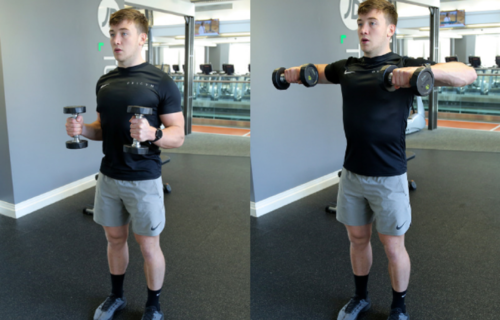
Set-Up and Equipment:
Grab a pair of light dumbbells and find enough space for you to extend your arms fully out to your sides.
Starting Position:
- The starting position for this variation is pretty much the same as we explained above with a slight tweak in your form.
- Once you’re in that starting position, bend your elbow to a 90°
Execution:
- For this variation, the execution of the move is exactly the same as the regular raise, but you need to keep your elbow bent in a right-angle.
The bent arm lateral raise is easier because holding your elbow in a right angle brings the weight closer to your body, making it easier to lift the dumbbell. Here’s how to do it:
Resistance Band Lateral Raise
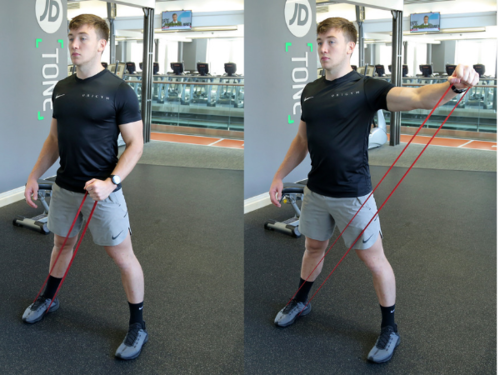
Set-Up and Equipment:
All you’ll need for this variation is a resistance band and plenty of space!
Starting Position:
- Stand on the resistance band and grab the handle with one hand.
- Grab the handle so that your arm is down by your side and your palm facing your legs.
- While you're holding the handle, there should be a slight bend in your elbow.
Execution:
- Keep your arm extended and lift the handles up your sides, the same movement as the dumbbell raise.
- Hold your arm level with your shoulder for a second and then slowly your arm back down to your side.
- Repeat the first set with this arm, and then swap.
If you want to ditch the dumbbells, try a resistance band lateral raise. Here’s how:
Seated Lateral Raise
Set-Up and Equipment:
All you need is a chair or a bench to perch yourself on. For a seated dumbbell lateral raise, grab a pair of dumbbells, too.
Starting Position:

- Sit on the bench with your back upright.
- Brace your core, it will help to keep your back straight.
- Hold your arms (and dumbbells if you’re using them) by your side – not forgetting to keep your elbow slightly bent.
- Look straight ahead.
Execution:
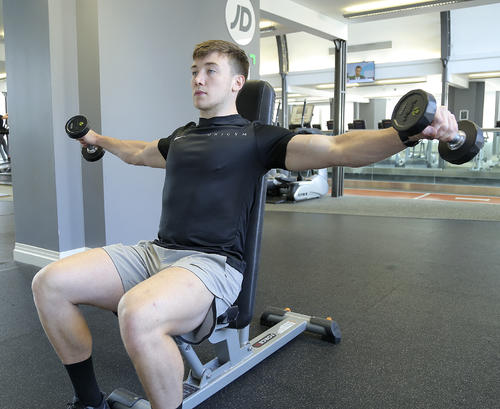
- Move your arms up and out to the side in the same way as you would for regular side raises.
- Hold this position for a second before lowering the dumbbells back to your sides at a controlled pace.
Check out the perfect execution, here:
If you’re still struggling, try the exercise on a lateral raise machine.
Make the Lateral Raise More Challenging
To make lateral raises harder, you can simply use heavier weights. It also helps to make the movement slower. Time how long it takes you to lower your arms from the cross position and increase this time every time you get comfortable with the move.
Another general tip to make the standard raise more difficult is to rotate your palms. As you lift your arms towards the parallel, tilt your hands forward like you’re pouring jugs of water. This will activate more of your muscle fibres, making your lateral delts work harder.
For more of a challenge, swap your dumbbells for a set of kettlebells. Dumbbells are equally balanced from end-to-end, but the weight of a kettlebell is uneven – the handle weighs a lot less than the ball. This means that lifting a kettlebell is harder to control, so a lat raise with a kettlebell forces your shoulder muscles to work harder which means one thing, better results!
Alternatives to Side Raises
Cable Lateral Raise
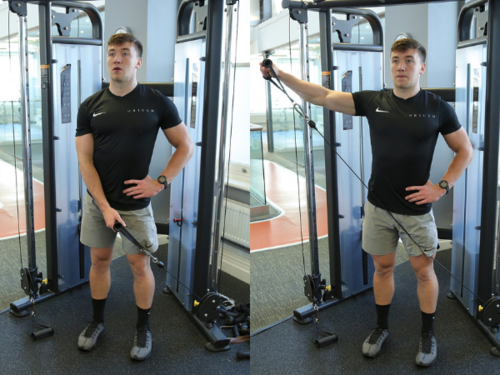
Set-Up and Equipment:
This one needs to be tried at the gym. You’ll need to find the cable machine and a cable attachment to act as a handle.
Starting Position:
- Attach the handle to the lowest pulley level.
- Stand to the side of the machine and reach across your body to grab the handle with one hand.
- This arm should be almost fully extended with a slight bend in the elbow.
- Hold onto the frame of the machine with your other hand (the one closest to the machine) if you need to.
Execution:
- Start the cable lateral raise by moving your arm up to the level of your shoulder.
- When your arm is parallel to the ground, hold the position for a second.
- Slowly lower your arm back down towards the starting position.
- Repeat the movement.
Check out this how-to video to perfect the cable lateral raise:
Using a cable machine for raises is a great way to keep tension on your lateral delts. If you can handle the front cable lateral raise, try this alternative:
Incline Lateral Raise
Set-Up and Equipment:
An incline lateral raise is a variation of the seated lateral raise. You’ll need to head to the gym and find an incline bench. Grab a light pair of dumbbells, too.
Starting Position:

- Sit on the incline bench with your back to the bench.
- Hold a dumbbell in each hand.
- Your arms should be pointing straight down towards the floor.
- Rest your head on the back of the seat and look straight ahead.
Execution:

- Just like the seated lateral raise, the movement of your arms is the same as the standard move.
- Raise your arms until they end up parallel to the floor and your shoulders.
- Hold your arms for a second at the top of the movement.
- Slowly lower your arms back down to the starting position as you would for the standard version of the exercise.
Bent over Lateral Raise
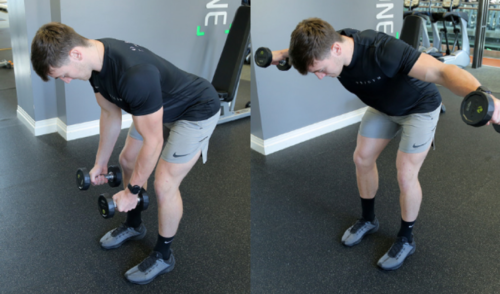
Set-Up and Equipment:
Grab a pair of dumbbells and find yourself some space.
Starting Position:
- Grab a dumbbell in each hand and hold them down your sides.
- With your knees slightly bent, bend at your hips so that your upper body is parallel to the ground.
- Keep your back flat and your arms straight, they should be positioned hanging beneath you.
- Don’t lock out your arms – there should be a slight bend in your elbow.
Execution:
- Raise the dumbbells up and out to your sides until your arms are level with your shoulders.
- Hold your arms parallel to the floor for a second.
- Slowly lower your arms back towards your starting, stopping just before you reach the position.
- Repeat the move.
Muscles Worked:
The muscles worked by this variation are slightly different from the lateral raise muscles worked. Whilst side raises work your lateral deltoid, the bent over lateral raise is better for working the posterior deltoid.
So, bent over lateral raises are great for targeting the muscle in the back of your shoulders. Switching between normal raises and the bent over raises is a great way to build strength and hypertrophy in your shoulders.
Before You Go!
That’s all for our ultimate guide to the lateral raise...
If you want to be the one guiding someone through their workout, why not check out our Level 3 Personal Trainer course?
Or, download our free prospectus first to see what you could be learning!

